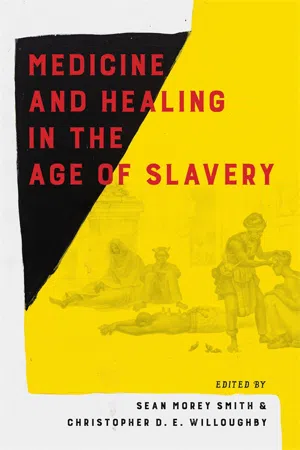![]()
PART I
KNOWLEDGE
![]()
ZEMIS AND ZOMBIES
Amerindian Healing Legacies on Hispaniola
LAUREN DERBY
The consequence of arrival, for European and Amerindians alike, was the advent of a modernity whose ruins we still inhabit.
—NEIL L. WHITEHEAD, Of Cannibals and Kings: Primal Anthropology in the Americas
Because of the slave trade you lose your mother; if you know your history, you know where you come from.
—SAIDIYA HARTMAN, Lose Your Mother: A Journey along the Atlantic Slave Route
In 1799, French physician and botanist Michel Étienne Descourtilz traveled to Saint-Domingue as the Haitian revolution was in full swing when he began to compile his monumental eight-volume compendia of flora and fauna. Working with a formerly enslaved African as his field assistant, he surveyed the recently freed slaves for the names and uses of the plants, thus his work is a rich compilation of slave and creole herbal knowledge not long after the peak moment of African arrivals during the midcentury sugar boom. I was surprised, however, to find that when Descourtilz inquired as to how the slaves had learned of the plants’ medical uses, frequently his informants cited their indigenous relatives and, in particular, their Native American mothers as the source of their plant knowledge.1 This datum raises a host of complex questions, a few of which I will take up here, including what indigeneity meant to slaves at a time when the Native American population was long gone, having been ravaged by disease, famine and violence, at a key moment of transition when African and African-descended slaves were becoming freedmen and citizens. Of course, revolutionary general Jean-Jacques Dessalines also reached for an emblem of indigeneity in 1804 when he renamed Saint-Domingue Ayti, the Arawak name for the island, in part because native symbols of indigeneity represented autochthony, as well “intense spirituality, aggressive power and self-determination,” but the question remains whether these gestures were merely forms of creole cultural appropriation, or something more.2
Notwithstanding that Hispaniola—the island shared by Haiti and the Dominican Republic—was where Christopher Columbus first landed and found the largest Native American population in the Caribbean, the standard narrative for the Caribbean is that the Taíno presence was wiped out within twenty years of conquest.3 This narrative of aboriginal disappearance has become a foundational myth within Caribbean historiography enabled by the myth of mestizaje. Yet as anthropologist Michel-Rolph Trouillot points out, historical narratives are shaped by unequal conditions of production, and these slave stories of hidden indigenous mothers have been lost within a historiography that has long emphasized indigenous destruction. Yet this popular archive may occlude a phantom subaltern presence lurking in the shadows if one can only discern what historian Carlo Ginzburg has termed “slender clues”—flourishes or marginalia such as fingerprints, rumors, offhanded comments or inadvertent details.4 It is also significant that the kinship link alleged in these popular slave genealogies is traced through the maternal line, since forging unions with Taíno women was a strategy of conquest which also rendered the indigenous legacy invisible given Spanish patriarchal hegemony.5 Furthermore, uncovering the impact of Taíno culture on Hispaniola today illustrates that Atlantic cultural exchanges did not solely happen between people of African and European descent. Native ways of living and being played a significant role in shaping the Atlantic World; despite gaps in the archive, it is essential to explore these indigenous legacies within creole healing cultures.
This essay considers one location where the indigenous presence has maintained its vitality beyond the grave through tracing its contribution to a particularly prestigious subset of vernacular knowledge—that of healing and sorcery practices on Hispaniola.6 One measure of its social value is that today recipes and rites related to sorcery actants are often jealously guarded by secrecy protocols, which were surely policed even more stringently in the past given successive antisuperstition campaigns in Haiti and military assaults on popular healers in the Dominican Republic.7 Anthropologist Roger Sansi reminds us that the concept of sorcery in the Black Atlantic was born of the Portuguese term feitiçaria which emerged within seventeenth-century encounters between European slave traders and coastal Africans.8 Processes of colonial racialization cast practices of the “left hand” as sinister since they involve manipulations of the spirit world, yet the ancestors are also protective, of course. Healing and harming are morally contrastive yet ultimately codependent and reside on a continuum since sorcery may involve sending spirits which cause illness, misfortune, or death as well as expelling those which have created bodily distress.9 For example, in colonial Saint-Domingue, slave healers practiced both divination and herbal medicine and were perceived as dangerous sorcerers.10
I would propose that several elements within the core grammar of sorcery and popular medicine on Hispaniola have roots in Amerindian practices, such as the use of toxins and binding. Here I focus on the use of what historian Pablo Gómez calls “ritual stones,” which may be descendants of the supernatural assistants the Taíno people called zemis or cemís.11 It thus takes up the challenge recently ushered forth by Marcy Norton and Ralph Bauer to rethink colonial systems in a way that challenges the heroic narrative of European agency by paying careful attention to signs of indigeneity that indicate more mutual coimbrication or “entanglement” than has previously been a...
